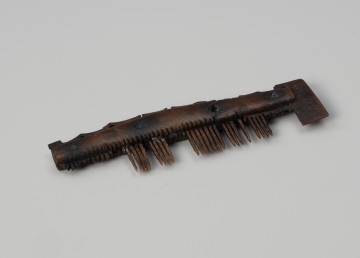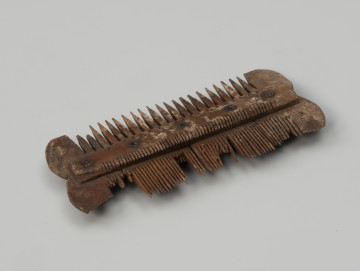
Antler comb
476 — 1250
National Museum in Szczecin
Part of the collection: Middle Ages
A antler comb discovered during archaeological research in Kamień Pomorski in the 1960s in an early medieval settlement, in a layer from the second half of the 10th century. The comb is a one-sided specimen with teeth on one side. It is made of rectangular toothed plates, which are joined by two facings fixed with rivets. The elements differentiating early medieval single-sided combs are the shape and decoration of the facing and the number of rivets, and the raw material from which they are made. The facings of the stone comb are arched, and their sides are cut straight. Projecting above the ridges are the tips of toothed plates - two in the centre and two on the sides - decorated with stylised animal heads, most probably horse heads. The facings have vertical grooves on the surface and a simple, double-stranded braid resembling a twisted rope. Iron rivets connect the toothed plates with the facings. Apart from the obvious function of taking care of hairstyle, combs of this type were used to maintain hygiene and comb out parasites. The comb from Kamień Pomorski is characterised by the co-occurrence of foreign ornamental elements, which include stylised horseheads, i.e., ornamentation originating from the Rhineland, with native Pomeranian elements in the form of grooves and braids. It is considered a local product modelled on products of foreign origin.
Sławomir Słowiński
Author / creator
Dimensions
cały obiekt: height: 3.4 cm, width: 22.3 cm
Object type
comb
Technique
drilling, printing, planing, cutting
Material
antlers
Creation time / dating
Creation / finding place
Owner
Muzeum Narodowe w Szczecinie
Identification number
Location / status

476 — 1250
National Museum in Szczecin

801 — 1201
National Museum in Szczecin

1176 — 1200
National Museum in Szczecin
DISCOVER this TOPIC
Museum of King Jan III's Palace at Wilanów
DISCOVER this PATH
Educational path